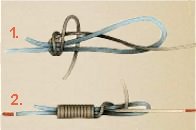HUNTING NEWS CATEGORIES
© 2010 Backcountry Press Outdoor News - All Rights Reserved Website Design by:
 | ||||
KNOTS
There are a large variety of knots for the outdoors including hunting, fishing or boating and each knot has specific properties and suitability for a range of tasks. Some knots are well-adapted to attach to particular objects such as another rope, cleat, ring, or stake. Other knots are made to bind or constrict around an object. Choosing the correct knot for the job at hand is one of the most fundamental aspects of using knots well.
 | ||||
Line Joining Knots
Tying line to line is critical. And when it's called for (for example, when you have a killer rig on 15-pound test line and you want to attach it to the 20-pound test line on your reel without having to retie the whole rig) you need a really good knot. These knots are tested and reliable for joining two pieces of fishing line.
Albright Knot
This knot was made famous by the well-known Florida guide Jimmy Albright, and is worthy enough to bear his name. It's an excellent knot for tying light test to heavy line. It also can be used to connect line to wire cable, nylon-coated wire, and even to small diameter single-strand wire leader.
The biggest "plus" for the Allbright (and the nail knot) is that one line grips the other, they do not intersect. Many knots joining two lines of different construction intersect with the possible result that the smaller harder line can cut through the bigger softer line and the knot fails. The Allbright and Nail knots are the strongest and safest ways to join two lines bar none.
One of the most reliable knots for tying together two lines of unequal diameter, the Albright works well when you have to tie the 15-pound test line on your rig to the 20-pound test you currently have on your reel spool or when tying monofilament backing to a fly line.










